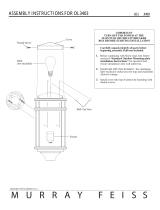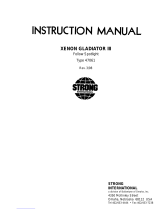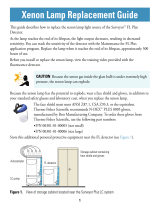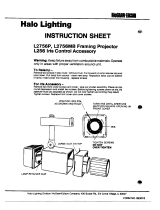Strong Enterprises FOLLOW SPOTLIGHT 48057 User manual
- Type
- User manual
This manual is also suitable for
Strong Enterprises FOLLOW SPOTLIGHT 48057 is a direct current follow spotlight complete with a xenon lamphouse, power supply, optical system, base and yoke assembly, and color boomerang. It utilizes proven design features of the Strong Xenon Super Trouper combined with advanced properties of the Strong Super Trouper II. Using a 700 watt xenon bulb as a light source, the Xenon Trouper meets or exceeds all professional requirements for short- to medium-throw follow spotlight applications.
The spotlight is equipped with an ammeter and running time meter. The ammeter indicates the operating current of the lamp, and the running time meter records the number of hours the lamp has operated. The lamp is ignited and extinguished by use of the LAMP switch mounted on the instrument panel. A DC Pulse Igniter Assembly requires no AC control circuit; it operates from DC open circuit voltage normally generated by the xenon power supply.
Strong Enterprises FOLLOW SPOTLIGHT 48057 is a direct current follow spotlight complete with a xenon lamphouse, power supply, optical system, base and yoke assembly, and color boomerang. It utilizes proven design features of the Strong Xenon Super Trouper combined with advanced properties of the Strong Super Trouper II. Using a 700 watt xenon bulb as a light source, the Xenon Trouper meets or exceeds all professional requirements for short- to medium-throw follow spotlight applications.
The spotlight is equipped with an ammeter and running time meter. The ammeter indicates the operating current of the lamp, and the running time meter records the number of hours the lamp has operated. The lamp is ignited and extinguished by use of the LAMP switch mounted on the instrument panel. A DC Pulse Igniter Assembly requires no AC control circuit; it operates from DC open circuit voltage normally generated by the xenon power supply.




















-
 1
1
-
 2
2
-
 3
3
-
 4
4
-
 5
5
-
 6
6
-
 7
7
-
 8
8
-
 9
9
-
 10
10
-
 11
11
-
 12
12
-
 13
13
-
 14
14
-
 15
15
-
 16
16
-
 17
17
-
 18
18
-
 19
19
-
 20
20
-
 21
21
-
 22
22
-
 23
23
-
 24
24
-
 25
25
-
 26
26
-
 27
27
-
 28
28
-
 29
29
-
 30
30
-
 31
31
-
 32
32
-
 33
33
-
 34
34
-
 35
35
-
 36
36
-
 37
37
-
 38
38
-
 39
39
-
 40
40
-
 41
41
-
 42
42
-
 43
43
Strong Enterprises FOLLOW SPOTLIGHT 48057 User manual
- Type
- User manual
- This manual is also suitable for
Strong Enterprises FOLLOW SPOTLIGHT 48057 is a direct current follow spotlight complete with a xenon lamphouse, power supply, optical system, base and yoke assembly, and color boomerang. It utilizes proven design features of the Strong Xenon Super Trouper combined with advanced properties of the Strong Super Trouper II. Using a 700 watt xenon bulb as a light source, the Xenon Trouper meets or exceeds all professional requirements for short- to medium-throw follow spotlight applications.
The spotlight is equipped with an ammeter and running time meter. The ammeter indicates the operating current of the lamp, and the running time meter records the number of hours the lamp has operated. The lamp is ignited and extinguished by use of the LAMP switch mounted on the instrument panel. A DC Pulse Igniter Assembly requires no AC control circuit; it operates from DC open circuit voltage normally generated by the xenon power supply.
Ask a question and I''ll find the answer in the document
Finding information in a document is now easier with AI
Other documents
-
 Generation Lighting OL3403CB Installation guide
Generation Lighting OL3403CB Installation guide
-
Warehouse of Tiffany NSC161244G01 Operating instructions
-
Warehouse of Tiffany LS56ABB20 Installation guide
-
 Strong International XENON GLADIATOR III User manual
Strong International XENON GLADIATOR III User manual
-
Toro Interlock Switch, Electric Blowers Installation guide
-
Triton MSA200 Operating instructions
-
Barco Ushio 2000W DXL-20BAF/L User manual
-
Qaba 340-005BU Assembly Instructions
-
 Thermo Fisher Scientific Xenon Lamp Replacement User guide
Thermo Fisher Scientific Xenon Lamp Replacement User guide
-
 Halo Lighting System L2756P User manual
Halo Lighting System L2756P User manual














































